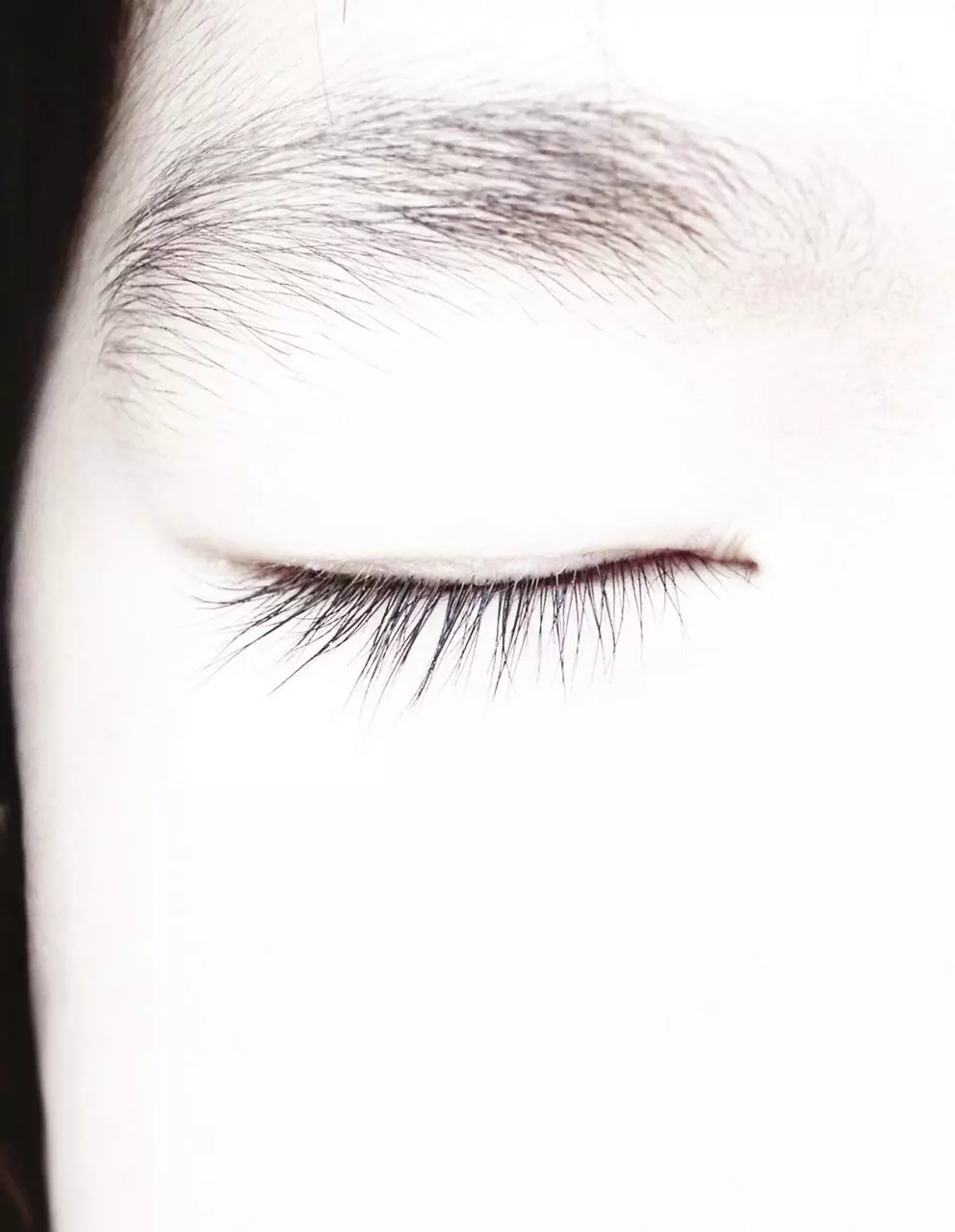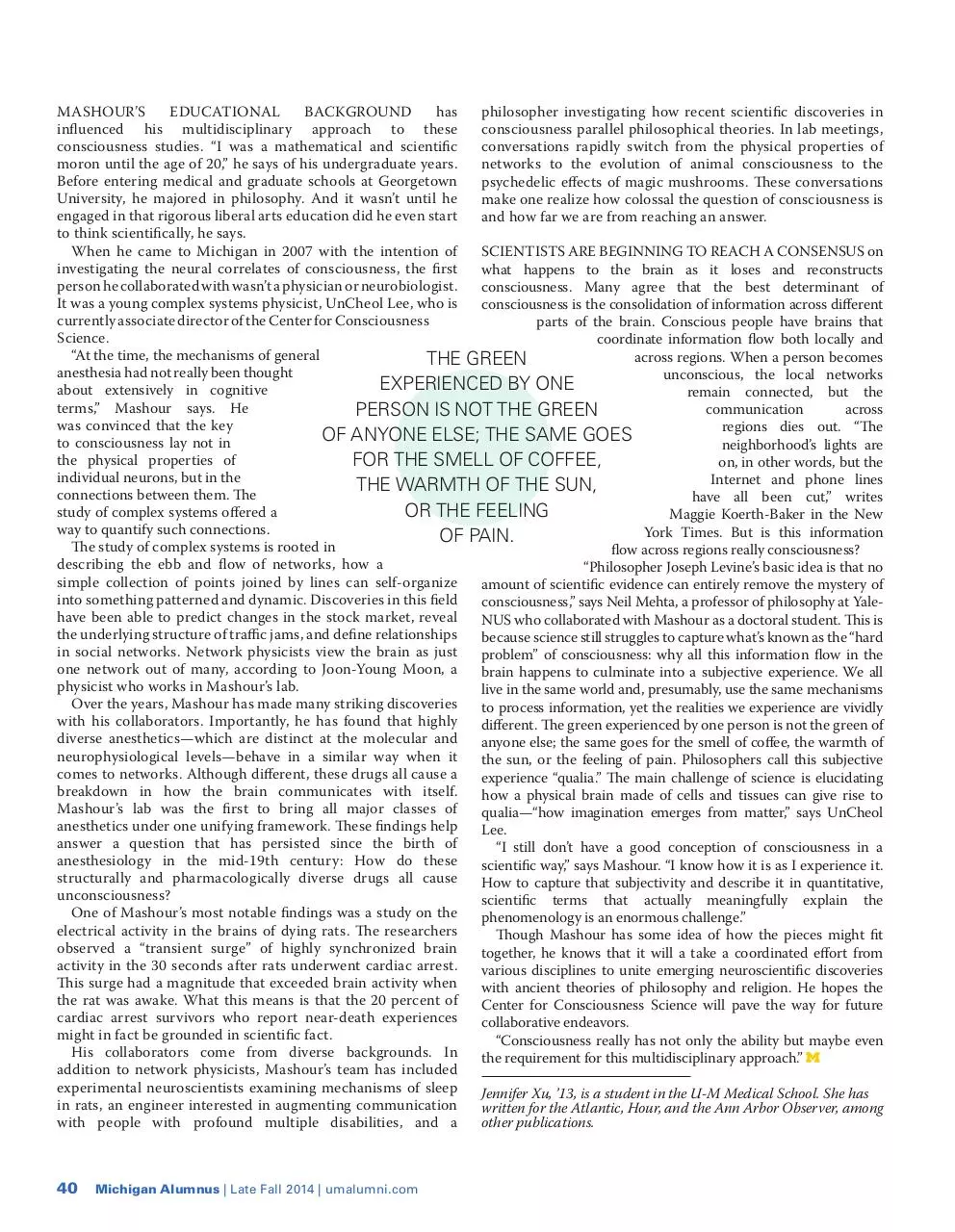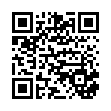Pages from Michigan Alumnus LF14.38 40 Consciousness (PDF)
File information
This PDF 1.6 document has been generated by Adobe InDesign CS6 (Macintosh) / Adobe PDF Library 10.0.1, and has been sent on pdf-archive.com on 26/12/2017 at 20:17, from IP address 172.115.x.x.
The current document download page has been viewed 202 times.
File size: 519.74 KB (3 pages).
Privacy: public file



File preview
38
Michigan Alumnus | Late Fall 2014 | umalumni.com
By Jennifer Xu, ’13
E
A new center
within the U-M
Medical School takes
a multidisciplinary approach
to reveal what it means
to be conscious.
VERY MORNING when we
awake, an entire world of images,
textures, sounds, and smells emerges around
us. We smell coffee, hear a chorus of birds, and squint at the
sun filtering through the curtains. We also experience a series of
internal sensations: a stream of jumbled thoughts, awareness of
ourselves, hunger, pain, happiness. All of this perceptual experience
isn’t the natural world; it’s our subjective representation of it. This is
the mysterious, impalpable quality we call consciousness.
The essential properties of consciousness have been matters of
philosophical debate since the 1600s, when French philosopher
René Descartes proclaimed that the mind and brain consisted of
different substances. But recently, scientists and doctors have
started asking new, compelling questions about how we construct
and experience reality. For instance, what does consciousness look
like mechanistically in the brain? Is it located in a specific region, or
is it a general process? Can it be measured?
At the U-M Medical School, an official center devoted to the topic
opened its doors in August: the Center for Consciousness Science.
This collaboration of anesthesiologists, physicists, neurobiologists,
biomedical engineers, psychiatrists, and philosophers seeks to find
scientific measures of subjective phenomena. The humanities have
batted around theories of consciousness for centuries. Now the
question remains: can science develop a theory that objectively
describes human consciousness?
THE CENTER FOR CONSCIOUSNESS SCIENCE is the brainchild
of George Mashour, an anesthesiologist and professor of
neuroscience in the Medical School. He envisioned a collaborative
endeavor that could advance multidisciplinary research in
consciousness studies while simultaneously capturing the
imagination and interest of the public.
“People on the street
have
these
fundamental
questions about their existence,”
Mashour says. “You don’t have to be a
scientist to ask, ‘Why am I here? Why am I aware?
How is it that I know the world?’”
The center uses anesthesiology as a cornerstone of its investigations.
Intuitively, this makes sense: Every day, approximately 60,000 patients
in the United States are shuttled in and out of unconsciousness under
the watchful eyes of anesthesiologists. But for a long time, physicians
didn’t understand how these anesthetics worked or what, exactly,
consciousness was. Research focused more on how to administer
drugs safely than on their exact mechanism on the brain.
The tide shifted in the early 1990s, when scientists started seeing
anesthesiology as a tool for investigating the human brain.
Anesthesiologists had been safely manipulating consciousness for
more than 200 years. These established techniques offered an ideal
substrate on which to test scientific hypotheses.
A typical experiment involves the electroencephalogram, a
machine attached to a tentacled mesh net that is snugly fit on the
subject’s scalp, like something out of a science fiction movie. Subjects
lie in a bed until drugs slowly extinguish their ability to respond to
commands. Meanwhile, the machine records the brain’s electrical
activity, a code that represents the billions of neurons in the brain
firing signals to each other. Somewhere, within those oscillating
signals, is where scientists believe the key to consciousness resides.
Mashour says the Center for Consciousness Science is searching
for both the “neural correlates and neural causes of consciousness”—
signatures in the brain’s electrical activity that are distinct to
particular states of consciousness. He hopes to better understand
the neural mechanisms underlying changes in brain state and fold
those findings into current philosophical and religious theories of
consciousness—objective measures of subjective experiences.
Michigan Alumnus | Late Fall 2014 | umalumni.com
39
MASHOUR’S
EDUCATIONAL
BACKGROUND
has
philosopher investigating how recent scientific discoveries in
influenced his multidisciplinary approach to these
consciousness parallel philosophical theories. In lab meetings,
consciousness studies. “I was a mathematical and scientific
conversations rapidly switch from the physical properties of
moron until the age of 20,” he says of his undergraduate years.
networks to the evolution of animal consciousness to the
Before entering medical and graduate schools at Georgetown
psychedelic effects of magic mushrooms. These conversations
University, he majored in philosophy. And it wasn’t until he
make one realize how colossal the question of consciousness is
engaged in that rigorous liberal arts education did he even start
and how far we are from reaching an answer.
to think scientifically, he says.
When he came to Michigan in 2007 with the intention of
SCIENTISTS ARE BEGINNING TO REACH A CONSENSUS on
investigating the neural correlates of consciousness, the first
what happens to the brain as it loses and reconstructs
person he collaborated with wasn’t a physician or neurobiologist.
consciousness. Many agree that the best determinant of
It was a young complex systems physicist, UnCheol Lee, who is
consciousness is the consolidation of information across different
currently associate director of the Center for Consciousness
parts of the brain. Conscious people have brains that
Science.
coordinate information flow both locally and
“At the time, the mechanisms of general
across regions. When a person becomes
THE GREEN
anesthesia had not really been thought
unconscious, the local networks
EXPERIENCED BY ONE
about extensively in cognitive
remain connected, but the
terms,” Mashour says. He
communication
across
PERSON IS NOT THE GREEN
was convinced that the key
regions dies out. “The
OF ANYONE ELSE; THE SAME GOES
to consciousness lay not in
neighborhood’s lights are
the physical properties of
FOR THE SMELL OF COFFEE,
on, in other words, but the
individual neurons, but in the
Internet and phone lines
THE WARMTH OF THE SUN,
connections between them. The
have all been cut,” writes
OR THE FEELING
study of complex systems offered a
Maggie Koerth-Baker in the New
way to quantify such connections.
York Times. But is this information
OF PAIN.
The study of complex systems is rooted in
flow across regions really consciousness?
describing the ebb and flow of networks, how a
“Philosopher Joseph Levine’s basic idea is that no
simple collection of points joined by lines can self-organize
amount of scientific evidence can entirely remove the mystery of
into something patterned and dynamic. Discoveries in this field
consciousness,” says Neil Mehta, a professor of philosophy at Yalehave been able to predict changes in the stock market, reveal
NUS who collaborated with Mashour as a doctoral student. This is
the underlying structure of traffic jams, and define relationships
because science still struggles to capture what’s known as the “hard
in social networks. Network physicists view the brain as just
problem” of consciousness: why all this information flow in the
one network out of many, according to Joon-Young Moon, a
brain happens to culminate into a subjective experience. We all
physicist who works in Mashour’s lab.
live in the same world and, presumably, use the same mechanisms
Over the years, Mashour has made many striking discoveries
to process information, yet the realities we experience are vividly
with his collaborators. Importantly, he has found that highly
different. The green experienced by one person is not the green of
diverse anesthetics—which are distinct at the molecular and
anyone else; the same goes for the smell of coffee, the warmth of
neurophysiological levels—behave in a similar way when it
the sun, or the feeling of pain. Philosophers call this subjective
comes to networks. Although different, these drugs all cause a
experience “qualia.” The main challenge of science is elucidating
breakdown in how the brain communicates with itself.
how a physical brain made of cells and tissues can give rise to
Mashour’s lab was the first to bring all major classes of
qualia—“how imagination emerges from matter,” says UnCheol
anesthetics under one unifying framework. These findings help
Lee.
answer a question that has persisted since the birth of
“I still don’t have a good conception of consciousness in a
anesthesiology in the mid-19th century: How do these
scientific way,” says Mashour. “I know how it is as I experience it.
structurally and pharmacologically diverse drugs all cause
How to capture that subjectivity and describe it in quantitative,
unconsciousness?
scientific terms that actually meaningfully explain the
One of Mashour’s most notable findings was a study on the
phenomenology is an enormous challenge.”
electrical activity in the brains of dying rats. The researchers
Though Mashour has some idea of how the pieces might fit
observed a “transient surge” of highly synchronized brain
together, he knows that it will a take a coordinated effort from
activity in the 30 seconds after rats underwent cardiac arrest.
various disciplines to unite emerging neuroscientific discoveries
This surge had a magnitude that exceeded brain activity when
with ancient theories of philosophy and religion. He hopes the
the rat was awake. What this means is that the 20 percent of
Center for Consciousness Science will pave the way for future
cardiac arrest survivors who report near-death experiences
collaborative endeavors.
might in fact be grounded in scientific fact.
“Consciousness really has not only the ability but maybe even
His collaborators come from diverse backgrounds. In
the requirement for this multidisciplinary approach.”
addition to network physicists, Mashour’s team has included
experimental neuroscientists examining mechanisms of sleep
Jennifer Xu, ’13, is a student in the U-M Medical School. She has
in rats, an engineer interested in augmenting communication
written for the Atlantic, Hour, and the Ann Arbor Observer, among
with people with profound multiple disabilities, and a
other publications.
40
Michigan Alumnus | Late Fall 2014 | umalumni.com
Download Pages from Michigan Alumnus LF14.38-40 Consciousness
Pages from Michigan Alumnus_LF14.38-40_Consciousness.pdf (PDF, 519.74 KB)
Download PDF
Share this file on social networks
Link to this page
Permanent link
Use the permanent link to the download page to share your document on Facebook, Twitter, LinkedIn, or directly with a contact by e-Mail, Messenger, Whatsapp, Line..
Short link
Use the short link to share your document on Twitter or by text message (SMS)
HTML Code
Copy the following HTML code to share your document on a Website or Blog
QR Code to this page

This file has been shared publicly by a user of PDF Archive.
Document ID: 0000713162.